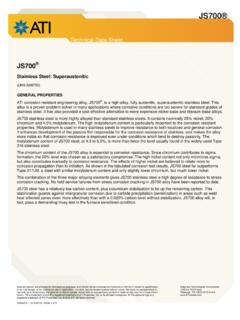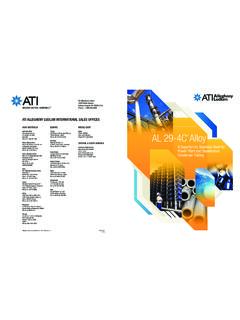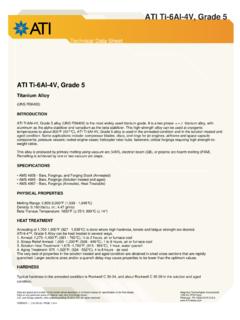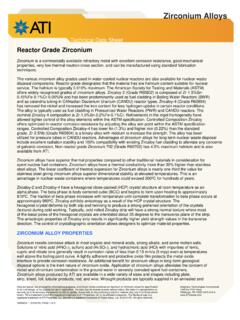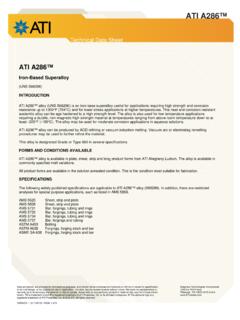Transcription of AL 29-4C For Heating and Ventilating
1 Data are typical, are provided for informational purposes, and should not be construed as maximum or minimum values for specification or for final design, or for a particular use or application. The data may be revised anytime without notice. We make no representation or warranty as to its accuracy and assume no duty to update. Actual data on any particular product or material may vary from those shown herein TM is trademark of and is registered trademark of ATI Properties, Inc. or its affiliated companies. The starburst logo is a registered trademark of ATI Properties, Inc.
2 SEA-CURE is a registered trademark of Plymouth Tube Company 2012 ATI. All rights reserved. VERSION 1 (4/18/2012): PAGE 1 of 7 Allegheny Technologies Incorporated 1000 Six PPG Place Pittsburgh, PA 15222-5479 Technical Data Sheet AL 29-4C For Heating and Ventilating AL 29-4C Alloy For Heating and Ventilating Stainless Steel (UNS S44735) TYPICAL COMPOSITION Element Wt. Percent Carbon Manganese Phosphorus Sulfur silicon Chromium Nickel Molybdenum Nitrogen Titanium+Columbium (Niobium) Iron < 29 4 Balance PRODUCT FORMS AVAILABLE Strip and Sheet: Widths up to 36" ( cm) Thickness to " ( mm) Vent Pipe: Sizes available on application Flexible Hose.
3 Sizes available on application GENERAL PROPERTIES AL 29-4C alloy is a superferritic stainless steel developed by ATI Allegheny Ludlum for extreme resistance to chloride ion pitting, crevice corrosion and stress corrosion cracking (SCC), as well as general corrosion in oxidizing and moderately reducing environments. The alloy was developed in the early 1980s for welded condenser tubing to be used in seawater and brackish water by the power generation industry. It is this extreme resistance to pitting and crevice corrosion that has led to the installation of over 2000 miles of AL 29-4C tubing in power plant condensers and heat exchangers.
4 The superferritic stainless steel AL 29-4C alloy shows excellent resistance to chloride ion pitting, crevice corrosion and stress corrosion cracking (SCC). This resistance makes it an ideal choice for battling the corrosive condensate of partially and fully condensing natural gas and propane burning appliances (except for high sulfur fuel sources). Its low alloy content, compared to other high-performance alloys, makes it an economical choice as well. Data are typical, are provided for informational purposes, and should not be construed as maximum or minimum values for specification or for final design, or for a particular use or application.
5 The data may be revised anytime without notice. We make no representation or warranty as to its accuracy and assume no duty to update. Actual data on any particular product or material may vary from those shown herein TM is trademark of and is registered trademark of ATI Properties, Inc. or its affiliated companies. The starburst logo is a registered trademark of ATI Properties, Inc. SEA-CURE is a registered trademark of Plymouth Tube Company 2012 ATI. All rights reserved. VERSION 1 (4/18/2012): PAGE 2 of 7 Allegheny Technologies Incorporated 1000 Six PPG Place Pittsburgh, PA 15222-5479 Technical Data Sheet AL 29-4C For Heating and Ventilating THE CONDENSATE PROBLEM High efficiency in gas Heating appliances is achieved when heat from the flue gas is extracted before venting it to the atmosphere.
6 Although natural gas (the fuel used for most of the currently available high efficiency home Heating appliances) is relatively clean burning, the products of combustion typically include nitrogen oxides, sulfur oxides and hydrogen chloride, as well as the expected water vapor and carbon dioxide. The hydrogen chloride comes from the combustion of chlorides (salt dust), chlorinated solvents, chlorofluorocarbons, and hypochlorite (bleach) vapors entrained in the combustion air supply. Efforts to reduce chloride sources by switching from indoor to outdoor air supplies have not been totally effective due to airborne salt dust (oceans, deserts, industry, road salt, etc.)
7 As well as household laundry vented emanations and pollution emissions. Nitrogen oxides are a typical by-product of combustion air. Sulfur is present at very low concentrations as odorant compounds added to natural gas. Condensation of these products of combustion yields an acidic solution which contains concentrations of nitric, nitrous, sulfuric, sulfurous and hydrochloric acids. Hydrogen fluoride is also encountered occasionally. This condensate can create either a predominantly oxidizing or reducing environment. Flue gas condensate becomes increasingly corrosive after it is concentrated by repeated condensing and evaporation, such as on heat exchanger surfaces or in vent pipe systems.
8 This environment is often extremely corrosive to ordinary stainless steels (304, 316, 430, 439, 444) and aluminum as displayed in Figure 1. Additionally, condensate in conjunction with cyclic thermal stresses and vibratory stresses from normal operation of a Heating appliance have caused high temperature plastics to crack and plastic vent pipe joints to fail, prompting consumer advisories. Figure 1. Gas-fired furnace flue gas corrosion results* *Heat Exchanger Simulator corrosion tests performed by Battelle Columbus for Brookhaven National Laboratory under contract to Department of Energy.
9 Reported in DOE Energy Conservation report titled Condensing Exchanger systems for Residential/ Commercial Furnaces and Boilers, Phase IV; dated Oct. 1985. *Chloride level measured in condensate developed in the five test zones. Data are typical, are provided for informational purposes, and should not be construed as maximum or minimum values for specification or for final design, or for a particular use or application. The data may be revised anytime without notice. We make no representation or warranty as to its accuracy and assume no duty to update. Actual data on any particular product or material may vary from those shown herein TM is trademark of and is registered trademark of ATI Properties, Inc.
10 Or its affiliated companies. The starburst logo is a registered trademark of ATI Properties, Inc. SEA-CURE is a registered trademark of Plymouth Tube Company 2012 ATI. All rights reserved. VERSION 1 (4/18/2012): PAGE 3 of 7 Allegheny Technologies Incorporated 1000 Six PPG Place Pittsburgh, PA 15222-5479 Technical Data Sheet AL 29-4C For Heating and Ventilating THE CONDENSATE SOLUTION Since 1983, furnace and vent manufacturers have specified AL 29-4C alloy for gas Heating appliance parts where condensing occurs. High temperature concerns coupled with corrosive condensate make AL 29-4C alloy the ideal choice.
